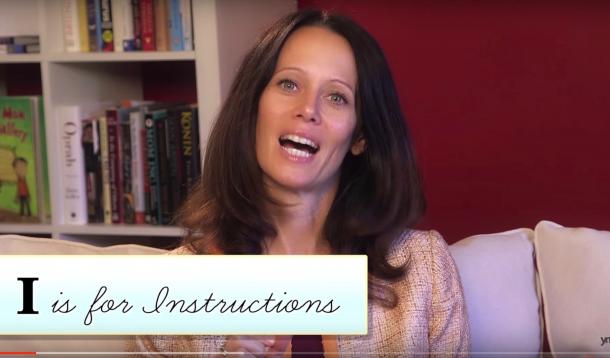
Thank you for continuing to watch our A to Z of Taming Tantrums series! Today’s episode is the letter I and I is for instructions.
How we deliver instructions will really change how our children respond to those. In this video, I walk through some tips on informing them what needs to in happen in a way that increases the chance our children will cooperate with us.
The key is to deliver those instructions in a clear, friendly, and also firm way. Make sure the instruction is not a question, and doesn’t end with "OK?" Please watch the video to learn more by clicking on the image below:
If you would like more help with delivering instructions, I recommend reading my two most-read posts of all time! This one: Stop Tantrums: 33 Phrases to Use With Toddlers and this one Tantrum Tamers: 32 Phrases to Use With 3 & 4 Year-Olds.
I’m such a believer that instruction delivery is crucial, that created an App for that! My Taming Tantrums app walks parents through what to say in a variety of challenging parenting situations, including when everyone is melting down. Here are some links to finding that in your iTunes smartphone app store in the US, in Canada, and in the Android app store.
Do you have any questions? Please do ask those in the YouTube video comments space or over on my Facebook page and I’ll be sure to answer them.
We're so excited to share with you the A to Z of Taming Tantrums video series!
Each week we'll share the next letter of the alphabet and Andrea will discuss how it relates to reducing tantrums - and improve our experience as parents! You can view each video here as they are added each Friday.


Have you heard of positive and negative core beliefs before? These are the beliefs we hold of ourselves, other people, and the world based on our life experiences.
These beliefs happen as a result of decisions or interpretations we make about situations we encounter. For example, when a child continually tries to build a tower, but it keeps falling, and the parents respond with this kind of language, “That tower building stuff is tricky. It looks like you’re really thinking about how to make this work,” the child is likely to believe (s)he is capable of figuring it out. In this example, the child might develop positive core beliefs.
Here is an example where a negative core belief might start to grow. In the same situation with a falling tower, consider the effect if the response to the child was this: “Stop doing that if it’s going to make you mad—it looks too hard for you. It’s not worth it.” In this example, a negative core belief of not being capable or giving up when things are hard might develop.
Here are three suggestions to using language that fosters the growth of positive core beliefs:
In order to foster the growth of positive core beliefs, focus on using strength-based and supportive language. At the same time, reduce the kinds of speaking that triggers our children’s defenses and coping mechanisms like: name calling, judgment, lecturing, blaming, shaming (saying things to embarrass them), demoralizing (pointing out what they are doing wrong), and threatening.
What is strength-based and supportive language? It is language where we focus on the effort, not on the result. And importantly, to correct them in a way that teaches a better way. Use language that shows your child you understand the outburst that happened, but it is important to do things differently the next time.
For example, “I heard you yell at your coach today. It can feel pretty hard to keep it together when we’re in the zone for a game, but it’s not okay to be hard on others. Let’s talk about a plan to managing that anger if it happens again.”
Think about how you can teach your child to behave more appropriately rather than snapping at him or her for losing their cool.
When a child doesn’t follow instructions, breaks something, doesn’t follow the rules or talks back, parents can correct the behaviour without attacking the personality of the child. Look at the misbehaviour as a mistake, not as a personality flaw.
We can also remind ourselves that mistakes happen for lots of reasons. Perhaps the child is compromised (exhausted, frustrated, tired or hungry) or simply hasn’t learned the skill she needs to prevent this mistake. We can’t get mad at a child for pouring her cereal onto a plate if we haven’t gone through the steps of showing her how to get her own cereal.
We also can’t get mad at a child for being mad. If parents start coaching their children at the toddler age how to process emotions and repeatedly walk through calm-down steps to develop rational thought, two-to-four year olds are still likely to throw, hit, bite, and freak out. It takes several years to grow the automatic response of calming when emotions surge. Please don’t be discouraged! Don’t see your child’s inability to stop a freak out as a failure of his character, but more as an opportunity for more practice. There are still a great number of adults who have a very hard time reeling in the strong instinctual reaction to freak out; it takes time to develop calming skills.
They key to doing this is to separate the child’s behaviour from who he or she is as a person. Look at the misbehaviour as a mistake, not as a personality flaw.
Here are some examples to show you how to do that:

Tricky
Use this word instead of hard, which can feel rigid and impossible. Tricky implies there is challenge involved but it’s a matter of maneuvering through the trickiness—to figure out a way through the maze—but that there is a way!
This is what I mean: “Wow. Tying shoes is tricky. Would you like to take a break, try again, or some help?” (I call this the “frustration mantra.”)
“It can be tricky not to hit your brother when you are mad, but that’s what we have to do. Hitting is not okay.” And then talk about a calm-down plan to handle big feelings.
You May
Instead of Please put your boots on, Can you put your boots on, or Would you like to try You may…
The first three examples are yes/ no questions, which give your child an opportunity to say, “NO!” I suggest steering away from those. Using, “you may” let’s your child know what needs to happen next and in a friendly manner.
Sure
Focus on what CAN happen rather than what cannot.
Children are likely to feel a push to do the opposite of what you tell them (that’s called “counterwill”) when they hear, “No,” and “Don’t,” or “Stop!” much of the day. Think of how you can word things to reduce the use of those words.
I suggest adopting a “sure” attitude: “Sure, you can do that. (These are the conditions to make that happen.)” This is what I mean: If a child is jumping on the sofa, instead of saying, “Stop jumping!” or “Get down! Don’t do that,” try this, “It looks like you want to jump. The jumping spot is over there. Sofas are for sitting.”
Here are a few more examples:
“Sure. We can get out the puzzles out right after your books are put in their away spots.”
“Great idea! After your cars are back in the bin, we can have a snack.”
“This is a walking place.” (Instead of “stop running”) or “Walking feet.” And if they are having too much trouble walking, take them to a place they can run around until they have all their ya-yas out.
If you would like more information about core beliefs, I recommend reading my full-length eBook, where I dedicated the first section to understanding those. Also, I created an app (for iPhone & Android), called Taming Tantrums, which is full of positive phrases to boost positive core beliefs. Do you have any questions? Please do ask those here or over on my Facebook page.
![]() RELATED: Negative Core Beliefs: How They Affect Kids and What to Do
RELATED: Negative Core Beliefs: How They Affect Kids and What to Do

Welcome back to the A to Z of Taming Tantrums video series. This week’s letter is H, and H is for help.
I chose the word “help” as part of this tantrum reduction toolbox because there’s one very important question we can ask ourselves about help, which takes the wind out of our child’s tantrum sails. When we consider this question, we put our focus on helping rather than getting caught up in everyone’s emotions, and the answer to it might actually stop the tantrum!
There’s a second reason the word “help” is important—being aware of how we can help ourselves. There is a term called parental self-care, which is how well we care for ourselves while raising children. Helping ourselves means having good parental self-care: it is so much easier to be the parent we want to be when we feel our own needs are being met.
In the video, I discuss what that important question is and how we can better meet our own needs. Please click on the link below to watch the video.
Do you find it hard to meet your own needs? I’d say my biggest need when I was parenting little ones was to be rested enough and also to know more about how toddler’s tick. If you’d like to read more about that topic, I recommend reading this post about the things that can reduce the stress of raising young children.
If you have questions or comments, I'd love to hear those. Please do comment on the video link on YouTube or over on my Facebook page, and I'll respond as soon as I can.
We're so excited to share with you the A to Z of Taming Tantrums video series!
Each week we'll share the next letter of the alphabet and Andrea will discuss how it relates to reducing tantrums - and improve our experience as parents! You can view each video here as they are added each Friday.
